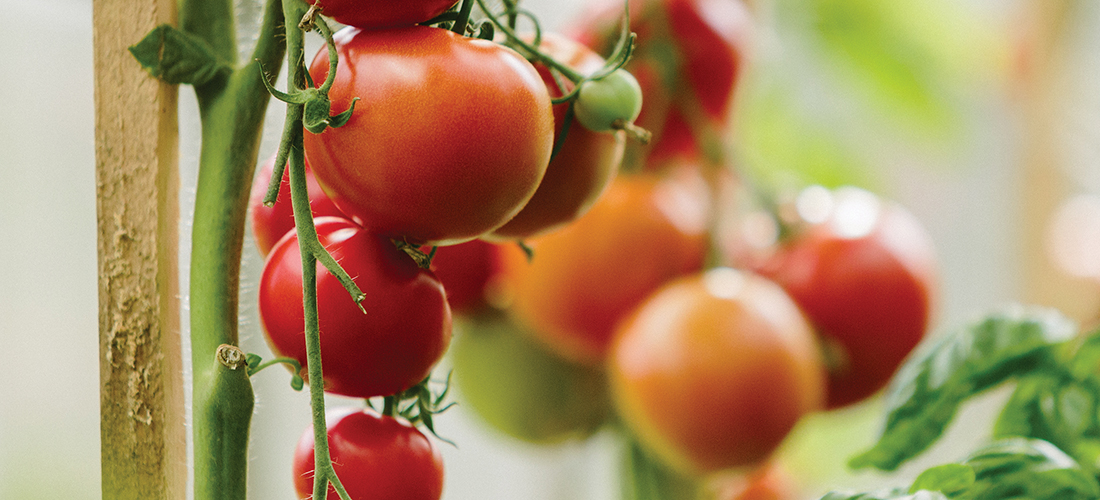
Tomato Tips
Prepare for your homegrown bounty
By Jan Leitschuh
You, or your friendly local farm stand or market, will have ripe, field-grown tomatoes by the end of this month. Even non-kitchen gardeners have been known to plant a tomato or two. It’s the juicy lure of summer meals with that fabulous homegrown tomato taste. With that in mind, here are a few random, but useful, tricks and tips:
— Stake or cage. If you haven’t already, do it now. By the end of the month, your vines will be so heavy with ripening fruits that the plant will sprawl along the ground, tomatoes will rot, and the plant will be exposed to pests and diseases. At this point, tall stakes may be your best bet. If you cage, get one tall enough that the vines don’t spill over the top, then snap under the growing weight of your hard-won harvest. Set cages or stakes deep in the ground so they don’t blow over, and tie vines loosely with soft cloth or twine, supporting the fruiting arms. The thin wire cones sold at supermarkets and some garden stores are really too short for tomatoes and are better suited to peppers and eggplant.
— Hunt for hornworms. Likely, you have a few on your plants right now, so put your glasses on and have a look. Search for chewed leaves. You’re looking for a fat, green, caterpillar-looking creature, especially on the undersides of your branches. Remove and squish (or feed to your neighbor’s chickens). Just a few hornworms can decimate a plant. Luckily, you’ll probably have just a few. Hornworms are tricky because of their exceptional green camouflage. They can hide in plain sight, but once you’ve spotted them, you can’t unsee them. Daily checks for a few weeks — with your cheaters on — will end this problem.
— Improve taste via soil. Generally, the better the soil, the better the flavor. Compost and a mineral-balanced tomato fertilizer are your friends. Unfortunately, by June, isn’t this like shutting the barn door after the mule has fled? Au contraire! It’s not too late to put in another round of tomato plants for late summer and fall harvests. In the early stages of growth, tomato plants need plenty of nitrogen to grow strong stems and plenty of leaves. Once the plant has matured, the major minerals of phosphorus and potassium are needed in greater amounts to allow the plant to switch to successful fruit production. Trace minerals are important as well. Potassium levels in the soil have a significant impact on the taste of the fruits, as do sulfur, boron, sodium and chlorine. Next year, ensure your soil contains the right balance of these nutrients, and you’ll be flooded with flavorful tomatoes come harvest time. I like a mineral product called SulPoMag that’s well-suited for our Sandhills soils.
— Improve taste via variety. Tomato taste is complex, and your original variety choice is important. With thousands of tomato varieties to choose from, each with its own unique flavor profile, the tender heirlooms often top the flavor tests. Store-bought tomatoes are bred with shipping and shelf life, not flavor, in mind. Heirlooms, however, do not have the disease resistance of some of the decent, more modern tomatoes like the popular Better Boy. So, plant some of both.
— Add Epsom salts. Here is a post-planting tweak you can do right now. The timing is “ripe.” Do your tomatoes lack that delicious homegrown taste? Are your plants slow to fruit or ripen, leaves curling or turning yellow between the leaf’s green veining? It may be a magnesium deficiency. This region of the country tends to have low magnesium in the soil. Epsom salts, or hydrated magnesium sulfate, can help boost your tomato yield and keep plants bushy and healthy. The fruits will grow larger and taste better, and the plants will better resist disease and bear longer. Use it as a soil drench or foliar spray. Epsom salts are highly soluble and provide two essential micronutrients: magnesium and sulfur.
Once a month, dissolve two tablespoons Epsom salts in a gallon of water and “drench” the soil around your plant. Thereafter, use plain water regularly until the following month, then repeat the Epsom drench every 30 days. This same mixture — two tablespoons in a gallon of water — can also be sprayed on the leaves as a foliar spray and the magnesium (and sulphur) will be taken up by the plant quickly. Be sparing, again on a monthly schedule.
— Don’t forget pruning. In May, did you prune your tomatoes? Yes, prune. Removing the lower leaves up from the first fruit, or flower cluster, helps fight off common foliar diseases that result from splashing dirt. If you didn’t do it then, do it now. Did you also manage to pinch off the suckers, those feral shoots that arise from the V between the main stem and tomato branches? Cut them off as soon as you see them forming. Pruning them does cut down on the amount of fruit you’ll get, but it also improves the health of the plant, and in the long run, leads to stronger plants that will produce through the whole season. If these suckers are allowed to grow, they will set fruit, but also crowd out the other branches in search of sunlight. That can lead to poor air circulation and fungal diseases. It can also cause fruit to ripen slowly, or not at all. If you don’t prune your plants, you’ll have a smaller and less tasty yield because the extra energy that goes to growing foliage won’t make its way into the fruit. Also, remove any dead or dying leaves to allow the plant to put its energy into fruit production. Wash hands between plants to avoid spreading disease inadvertently.
— Water properly. Keep water off leaves. Tomato leaves are born trying to grab onto a foliar disease, it seems. Proper watering — and mulch — helps prevent splashing dirt onto the leaves. Slight water stress at the time of picking improves flavor, too, since it avoids dilution. Perhaps water in the morning and pick in the afternoon — for that delicious suppertime BLT or Caprese salad. There’s no need to guess when to water your tomato plants. Simply stick your index finger into the soil; if it feels dry, it’s time to water. If it’s moist, you’re good to go. If plants are drooping or wilting, water them deeply immediately and add mulch to protect roots and conserve soil moisture.
— Use the right pots fo container plantings. “Water and feed” is your mantra. Your potted tomato, a heavy feeder, is completely dependent on you. Use determinate (shorter and bushier varieties) or special “bush” tomatoes. Most determinate tomatoes (those that grow to a designated height then stop) are perfect for large, 5-10-gallon pots. Also, roots tend to migrate to the outside of their container. On a blazing day, this can lead to root burn on the sunny side. I’ll set a cheap, large nursery pot within my nicer pot to avoid this, with a little air gap of mulch or sand on the sides. At least use a light colored, reflective pot for your tomatoes if not using the pot-in-a-pot method.
— Companions are helpful. Basil. You’ll pair it with ‘maters in the cook pot, so why not in the garden? Besides culinary considerations, some say basil plants help deter certain pests like whiteflies or thrips. I know for a fact a crushed basil leaf, rubbed on the arms, deters evening mosquitoes. Others swear that tomatoes are tastier with basil planted nearby — you can be the judge of that. Garlic is also said to help repel pests, and that may include deer. Marigolds, cheerful little things, discourage root-knot nematodes. Some gardeners believe marigolds deter tomato hornworms and thrips too.
— Beware non-companions. Avoid planting sworn enemies nearby, such as cabbage or corn. These are such heavy feeders, they will pull nutrients from your tomatoes. Plus, corn earworm, Heliothus zea, known by another name, tomato fruitworm, will attack your tomatoes. Fennel is another unpleasant companion, exuding an unpleasant substance that discourages its neighbors. Also avoid planting other members of the tomato family — eggplant, Irish potatoes and bell peppers. They share diseases.
— Treat black spots. Tomatoes on the vine sometimes get black spots on the bottom, called blossom end rot. This is usually caused by a calcium deficiency. Lime or a good tomato fertilizer will help the issue, or next year you can put crushed egg shells in the soil around the plant. Commercial growers will use a calcium spray at the first sign of it.
— Plan for sbundance. Because it’s almost here. Start Googling recipes, and ways to put up and use your harvest. From canning to salsa to freezing to sun-dried tomatoes, from pizza sauce to tomato chutney to ratatouille, get your tomato game on. By July, you’ll be swimming in delicious, homegrown fruits. Lucky you! Don’t forget to share with friends. PS
Jan Leitschuh is a local gardener, avid eater of fresh produce and co-founder of Sandhills Farm to Table.





